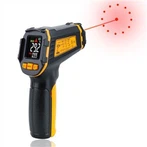Ten techniques for fault diagnosis of instruments such as multimeters
1. Percussion hand pressure method
Ø It is common to encounter the phenomenon of good and bad operation of the instrument. Most of this phenomenon is caused by poor contact or false soldering. For this situation, tapping and hand pressure methods can be used. The so-called "knocking" is to gently tap the plug-in board or component with a small rubber hammer or other knocking object on the part where the fault may occur to see if it will cause an error or shutdown. The so-called "hand pressure" means that when a fault occurs, turn off the power, press the plug and socket firmly with your hands again, and then turn it on again to see if the fault will be eliminated. If you find that the case is normal when you knock it once, but it is not normal when you knock it again, it is best to re-insert all the connectors firmly and try again. If you are troubled and unsuccessful, you have to find another way.
2. Observation method
ØUse vision, smell and touch. Sometimes, damaged components will discolor, blister, or have burnt spots; burned components will produce some special smell; short-circuited chips will become hot; and welding or desoldering can also be observed with the naked eye. .
3. Elimination method
Ø The so-called troubleshooting method is to determine the cause of the fault by unplugging and plugging in some plug-in boards and devices in the machine. When the instrument returns to normal after removing a certain plug-in board or device, it means that the fault occurred there.
4. Substitution method
Ø It requires two instruments of the same model or sufficient spare parts. Replace a good spare part with the same component on the faulty machine to see if the fault is eliminated.
5. Comparison method
Ø It is required to have two instruments of the same model and one of them is running normally. To use this method, you must also have the necessary equipment, such as a multimeter, oscilloscope, etc. According to the nature of comparison, there are voltage comparison, waveform comparison, static impedance comparison, output result comparison, current comparison, etc. The specific method is: let the faulty instrument and the normal instrument run under the same conditions, then detect the signals at some points and compare the two measured signals. If there are differences, you can conclude that the fault lies here. This method requires maintenance personnel to have considerable knowledge and skills. Ten techniques for fault diagnosis of instruments such as multimeters
6. Heating and cooling method
Ø Sometimes, the instrument will malfunction when it works for a long time, or when the working environment temperature is high in summer. It will turn off and check if it is normal. After a while, it will turn on again and it will be normal. After a while, the instrument will malfunction again. This phenomenon is caused by the poor performance of individual ICs or components and the failure of high-temperature characteristic parameters to meet the index requirements. In order to find out the cause of the fault, the temperature rising and cooling method can be used. The so-called cooling means that when a fault occurs, use cotton fiber to wipe anhydrous alcohol on the parts where the fault may occur to cool it down and observe whether the fault is eliminated. The so-called heating refers to artificially raising the ambient temperature, such as using a soldering iron close to the suspected part (be careful not to raise the temperature too high to damage normal components) to see if a fault occurs.
7. Shoulder riding method
Ø The shoulder-riding method is also called the parallel method. Place a good IC chip on the chip to be inspected, or connect good components (resistors, capacitors, diodes, transistors, etc.) in parallel with the components to be inspected and maintain good contact. If the fault is caused by an open circuit or internal circuit within the device, Reasons such as poor contact can be eliminated by this method.
8. Capacitor bypass method
Ø When a strange phenomenon occurs in a certain circuit, such as a disordered display, the capacitor bypass method can be used to determine the circuit part that is likely to be faulty. Connect the capacitor across the power supply and ground terminals of the IC; connect the transistor circuit across the base input terminal or collector output terminal to observe the impact on the fault phenomenon. If the capacitor bypass input is inactive and the fault disappears when its output is bypassed, the fault is determined to be in this circuit.
9. Status adjustment method
Ø Generally speaking, do not touch the components in the circuit casually before the fault is determined, especially adjustable components, such as potentiometers, etc. However, if re-reference measures are taken in advance (for example, marking the position or measuring the voltage or resistance value before touching), touching is still allowed when necessary. Maybe after a change sometimes the glitch will go away.
10. Isolation Law
Ø The fault isolation method does not require the same type of equipment or spare parts for comparison, and it is extremely reliable. According to the fault detection flow chart, segmentation and encirclement gradually narrow the fault search scope, and then cooperate with methods such as signal comparison and component exchange, and the fault will generally be found quickly.






